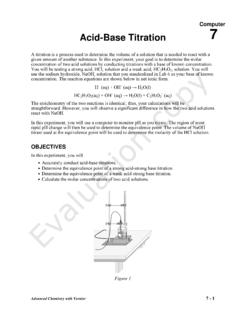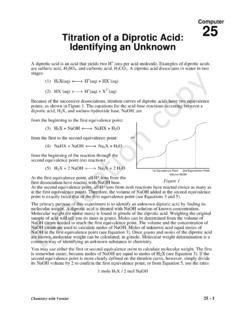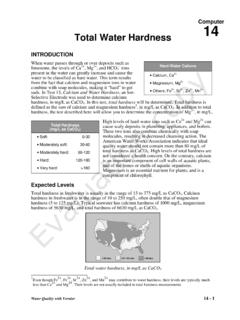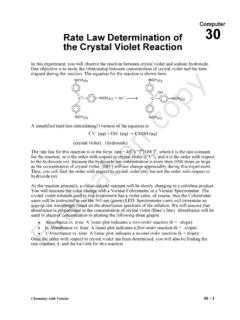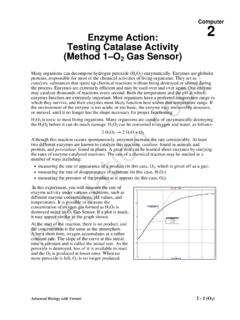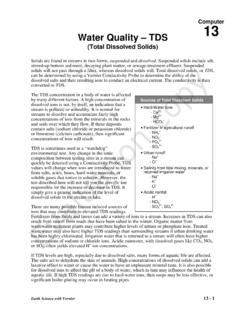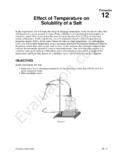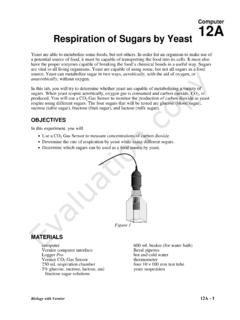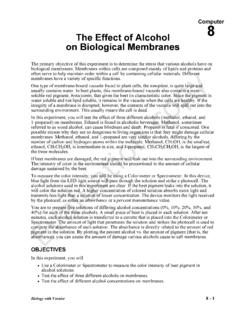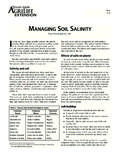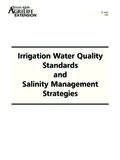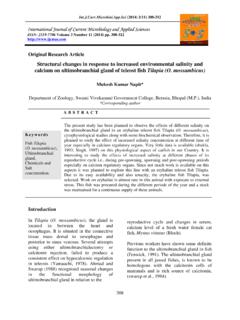Transcription of Test 15 Cl and Salinity - Vernier Software & …
1 Computer 15 Water Quality with Vernier 15 - 1 Chloride and Salinity INTRODUCTION Chloride Chloride, in the form of the Cl ion, is one of the major inorganic anions, or negative ions, in saltwater and freshwater. It originates from the dissociation of salts, such as sodium chloride or calcium chloride, in water. NaCl(s) Na+(aq) + Cl (aq) CaCl2(s) Ca2+(aq) + 2 Cl (aq) These salts, and their resulting chloride ions, originate from natural minerals, saltwater intrusion into estuaries, and industrial pollution.
2 There are many possible sources of manmade salts that may contribute to elevated chloride readings. Sodium chloride and calcium chloride, used to salt roads, contribute to elevated chloride levels in streams. Chlorinated drinking water and sodium-chloride water softeners often increase chloride levels in wastewater of a community. In drinking water, the salty taste produced by chloride depends upon the concentration of the chloride ion. Water containing 250 mg/L of chloride may have a detectable salty taste if the chloride came from sodium chloride. The recommended maximum level of chloride in drinking water is 250 mg/L. Salinity Salinity is the total of all non-carbonate salts dissolved in water, usually expressed in parts per thousand (1 ppt = 1000 mg/L).
3 Unlike chloride (Cl ) concentration, you can think of Salinity as a measure of the total salt concentration, comprised mostly of Na+ and Cl ions. Even though there are smaller quantities of other ions in seawater ( , K+, Mg2+, or SO42 ), sodium and chloride ions represent about 91% of all seawater ions. Salinity is an important measurement in seawater or in estuaries where freshwater from rivers and streams mixes with salty ocean water. The Salinity level in seawater is fairly constant, at about 35 ppt (35,000 mg/L), while brackish estuaries may have Salinity levels between 1 and 10 ppt. Since most anions in seawater or brackish water are chloride ions, Salinity can be determined from chloride concentration.
4 The following formula is used: Salinity (ppt) = Cl (mg/L) A Chloride Ion-Selective Electrode can be used to determine the chloride concentration, which is converted to a Salinity value using the above formula. Salinity can also be measured in freshwater. Compared to seawater or brackish water, freshwater has much lower levels of salt ions such as Na+ and Cl ; in fact, these ions are often lower in concentration than hard-water ions such calcium (Ca2+) and bicarbonate (HCO3 ). Because Sources of Chloride Ions River streambeds with salt-containing minerals Runoff from salted roads Irrigation water returned to streams Mixing of seawater with freshwater Chlorinated drinking water Water softener regeneration Evaluation copy Computer 15 15 - 2 Water
5 Quality with Vernier Salinity readings in freshwater will be significantly lower than in seawater or brackish water, readings are often expressed in mg/L instead of ppt (1 ppt = 1000 mg/L). Increased Salinity levels have been observed in the lower reaches of the Colorado and Rio Grande rivers, due to return of irrigation water (see Table 1). In these arid regions of the United States, water readily evaporates during irrigation, resulting in high concentrations of salt ions in the water returned to the rivers. Salinity is also of interest in bodies of water where seawater mixes with freshwater, since aquatic organisms have varying abilities to survive and thrive at different Salinity levels.
6 Saltwater organisms survive in Salinity levels up to 40 ppt, yet many freshwater organisms cannot live in Salinity levels above 1 ppt. Expected Levels Seawater has a chloride ion concentration of about 19,400 mg/L (a Salinity of ppt). Brackish water in tidal estuaries may have chloride levels between 500 and 5,000 mg/L ( Salinity of 1 to 10 ppt). Even freshwater streams and lakes have a significant chloride level that can range from 1 to 250 mg/L ( Salinity of to ppt). Table 1: Chloride and Salinity in Selected Sites Site (fall season) Chloride (mg/L) Salinity (mg/L) Salinity (ppt) Columbia River, Newport, WA Mississippi River, Memphis, TN Rio Grande River, San Marcial, NM 56 101 Rio Grande River, Brownsville, TX 220 397 Colorado River, State Line, CO-UT 67 121 Colorado River, Andrade, CA 190 343 Summary of Methods Method 1: Chloride Concentration and Salinity (ISE) A Vernier Chloride Ion-Selective Electrode is used to measure the chloride ion concentration in the water (in mg/L) either on site or after returning to the lab.
7 Salinity can be determined using the relationship, Salinity (ppt) = Cl (mg/L). Method 2: Salinity Using a Conductivity Probe (Seawater or Brackish Water) A Vernier Conductivity Probe is used to measure the Salinity value of the water (in ppt). If Salinity values exceed 13 ppt, dilution of samples, as described in the procedure, will be necessary. This method uses the assumption that most of the ions in the solution are non-carbonate salt ions ( , Na+, K+, or Cl ), and converts the conductivity reading to a Salinity value. Chloride and Salinity Water Quality with Vernier 15 - 3 Method 1: CHLORIDE CONCENTRATION AND Salinity (ISE) Materials Checklist ___ computer ___ Low Standard (10 mg/L Cl ) ___ Vernier computer interface ___ High Standard (1000 mg/L Cl ) ___ Logger Pro ___ Very High Standard (20,000 mg/L Cl ) ___ Chloride Ion-Selective Electrode ___ tissues ___ wash bottle with distilled water ___ small paper or plastic cup (optional) Advanced Preparation The Vernier Chloride Ion-Selective Electrode (ISE) must be soaked in the Chloride High Standard solution (included with the ISE) for 15 30 minutes.
8 Important: Make sure the electrode is not resting on the bottom, and that the small white reference contacts are immersed. Make sure no air bubbles are trapped below the electrode. If the ISE needs to be transported to the field during the soaking process, use the Short-Term ISE Soaking Bottle. Remove the cap from the bottle and fill it 3/4 full with High Standard. Slide the bottle s cap onto the ISE, insert it into the bottle, and tighten. Important: Do not leave the ISE soaking for more than 24 hours. Long-term storage should be in the Long-Term ISE Storage Bottle. Collection and Storage of Samples 1. This test can be conducted on site or in the lab.
9 A 100 mL water sample is required. 2. It is important to obtain the water sample from below the surface of the water and as far away from shore as is safe. If suitable areas of the stream appear to be unreachable, samplers consisting of a rod and container can be constructed for collection. Refer to page Intro-4 of the Introduction of this book for more details. Testing Procedure 1. Position the computer safely away from the water. Keep water away from the computer at all times. 2. Prepare the Chloride Ion-Selective Electrode (ISE) for data collection. a. The ISE should be soaking in the High Standard. Make sure that it is not resting on the bottom of the container, and that the small white reference contacts are immersed.
10 B. Plug the ISE Sensor into Channel 1 of the Vernier interface. 3. Prepare the computer for data collection by opening the file 15 Chloride ISE from the Water Quality with Vernier folder of Logger Pro. ISE soaking for travel Computer 15 15 - 4 Water Quality with Vernier 4. You are now ready to calibrate the Calcium ISE.
